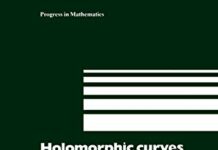
Ebook Info
- Published: 2014
- Number of pages: 610 pages
- Format: PDF
- File Size: 4.98 MB
- Authors: Michèle Audin
Description
This book is an introduction to modern methods of symplectic topology. It is devoted to explaining the solution of an important problem originating from classical mechanics: the ‘Arnold conjecture’, which asserts that the number of 1-periodic trajectories of a non-degenerate Hamiltonian system is bounded below by the dimension of the homology of the underlying manifold.The first part is a thorough introduction to Morse theory, a fundamental tool of differential topology. It defines the Morse complex and the Morse homology, and develops some of their applications.Morse homology also serves a simple model for Floer homology, which is covered in the second part. Floer homology is an infinite-dimensional analogue of Morse homology. Its involvement has been crucial in the recent achievements in symplectic geometry and in particular in the proof of the Arnold conjecture. The building blocks of Floer homology are more intricate and imply the use of more sophisticated analytical methods, all of which are explained in this second part.The three appendices present a few prerequisites in differential geometry, algebraic topology and analysis.The book originated in a graduate course given at Strasbourg University, and contains a large range of figures and exercises. Morse Theory and Floer Homology will be particularly helpful for graduate and postgraduate students.
User’s Reviews
Editorial Reviews: Review From the book reviews:“The present book is an excellent, detailed and self-contained introduction to Morse theory and Floer homology which makes both topics easily accessible to graduate or even advanced undergraduate students.” (Sonja Hohloch, Mathematical Reviews, August, 2014)“Morse Theory and Floer Homology is a relatively high-level introduction to, and in fact a full account of, the extremely elegant and properly celebrated solution to the Arnol’d problem by the prodigious and tragic Andreas Floer … . the book is exceptionally well written. Indeed, this is a very good book on a beautiful and important subject and will richly repay those who take the time to work through it.” (Michael Berg, MAA Reviews, February, 2014) From the Back Cover This book is an introduction to modern methods of symplectic topology. It is devoted to explaining the solution of an important problem originating from classical mechanics: the ‘Arnold conjecture’, which asserts that the number of 1-periodic trajectories of a non-degenerate Hamiltonian system is bounded below by the dimension of the homology of the underlying manifold.The first part is a thorough introduction to Morse theory, a fundamental tool of differential topology. It defines the Morse complex and the Morse homology, and develops some of their applications.Morse homology also serves a simple model for Floer homology, which is covered in the second part. Floer homology is an infinite-dimensional analogue of Morse homology. Its involvement has been crucial in the recent achievements in symplectic geometry and in particular in the proof of the Arnold conjecture. The building blocks of Floer homology are more intricate and imply the use of more sophisticated analytical methods, all of which are explained in this second part.The three appendices present a few prerequisites in differential geometry, algebraic topology and analysis.The book originated in a graduate course given at Strasbourg University, and contains a large range of figures and exercises. Morse Theory and Floer Homology will be particularly helpful for graduate and postgraduate students.
Reviews from Amazon users which were colected at the time this book was published on the website:
⭐One of the unique features of Morse theory that makes it somewhat rare in modern mathematics is that it has a very intuitive geometric content. Critical points, level surfaces, tangent spaces, transversality, and differentiable functions are all things that are easily visualized even if stated in the rigorous language of differential topology, a field that Morse theory is part of, and one that has considerable applications not only in mathematics but in physics, economics, and network science.From the standpoint of the field of physics, Hamiltonian mechanics, and its dual, Lagrangian mechanics are also very understandable from a geometric point of view as soon as one gets use to thinking in terms of phase spaces and least action principles. Indeed, the time evolution of conservative Hamiltonian systems preserves the area in phase space, and phase space diagrams can reflect the periodicity (or lack thereof) of the time dependence of mechanical systems.The authors of this book bring together Morse theory and Hamiltonian mechanics in the context of symplectic topology and nonlinear partial differential equations, summarizing in meticulous detail a subject that began with the late mathematician Andreas Floer. The goal of the book is to prove the Arnold conjecture, which essentially gives a bound on the number of fixed points of particular types of Hamiltonian diffeomorphisms on a symplectic manifold.To achieve this goal requires studying the solutions of a particular type of partial differential equation, called the ‘Floer equation’, which defines the flow of the gradient of functional acting on the space of loops on the symplectic manifold. As the authors show, the conjecture is straightforward to prove for the case where the Hamiltonian is independent of time. The general proof of the Arnold conjecture requires many pages to complete, but the authors guide the reader every step of the way, and spend time in discussing the required symplectic geometry and global analysis needed for working in the context of infinite-dimensional Banach manifolds.The authors give very understandable discussions of the notions of the Maslov index and the phenomenon of “bubbling” in symplectic topology. Readers familiar with the Yang-Mills equations in high energy physics may have ran into the bubbling phenomena when studying these equations. In this book it arises when proving the compactness of the space of solutions to the Floer equation. Bubbling is shown to arise because of the behavior of the gradient of symplectic balls with small radius, and is prohibited by making the ‘asphericity’ assumption, namely that the symplectic manifold not contain any spheres of nonzero symplectic area.Almost complex structures are intimately connected with symplectic topology and in this book appear in the Floer equation via an endomorphism of the symplectic manifold that squares to -1. The famous J-holomorphic curves are solutions of the Floer equation when the Hamiltonian is zero, where the Floer equation reduces to the ordinary Cauchy-Riemann equation.When studying the book it is readily apparent that the proof is harder than its Morse theory analog, and the reviewer found it was easy to get lost in the proofs of the lemmas and propositions at a first reading. This is especially true in Chapter 9, which is probably the most important one in the book since it shows the needed property of the differential of the Floer complexes, namely that is squares to zero. With patience though, readers will be able to get through this chapter and get a deep appreciation of the topic of Floer homology.For those readers who are interested, the book can also serve as an excellent warm-up for a future study of Lagrangian intersection theory and Floer cohomology, a topic that has seen a lot of development in recent years, but is formidable in its level of abstraction. Some of the exercises in the back of the book are geared towards developing an understanding of Lagrangian submanifolds of symplectic manifolds.
⭐On the whole, I think the authors do a very good job of explaining everything in detail. If one wants to have a good understanding of Morse and Hamiltonian Floer theory, after persisting, one will find reading the book to be fruitful.However, I think this is also one of the weaknesses of the book. When the proofs become very detailed, it’s easy to lose sight of the geometry and also lengthens the overall reading. Thus, I don’t think this book is the most efficient way to learn Hamiltonian Floer theory but it is certainly very thorough. For a more efficient way through, perhaps Dietmar Salamon’s lecture notes serve.I also wish the book was structured somewhat differently but this is a small deal. In ch. 8 for example, in order to prove transversality of the Floer equation, they made use of the fact that solutions are “somewhere injective,” postponing the proof of this claim. Then, when proving this injectivity result, they referenced an analytic continuation result but postponed its proof. This sort of postponing happens a few times and while it may maintain the flow of the exposition, I think presenting analytic continuation prior to proving transversality may be better. It shows up in other geometric settings with elliptic PDEs (such as Seiberg-Witten theory) and so is well-worth giving some attention to. It does seem odd to me that the authors decide to show the Floer equation is Fredholm, a rather difficult task, when it could be done more easily with some elliptic PDE theory.One final remark: There is a mistake on p. 377. They apply a lemma to a vector field which doesn’t satisfy the hypothesis of the lemma.
Keywords
Free Download Morse Theory and Floer Homology (Universitext) 2014th Edition in PDF format
Morse Theory and Floer Homology (Universitext) 2014th Edition PDF Free Download
Download Morse Theory and Floer Homology (Universitext) 2014th Edition 2014 PDF Free
Morse Theory and Floer Homology (Universitext) 2014th Edition 2014 PDF Free Download
Download Morse Theory and Floer Homology (Universitext) 2014th Edition PDF
Free Download Ebook Morse Theory and Floer Homology (Universitext) 2014th Edition


